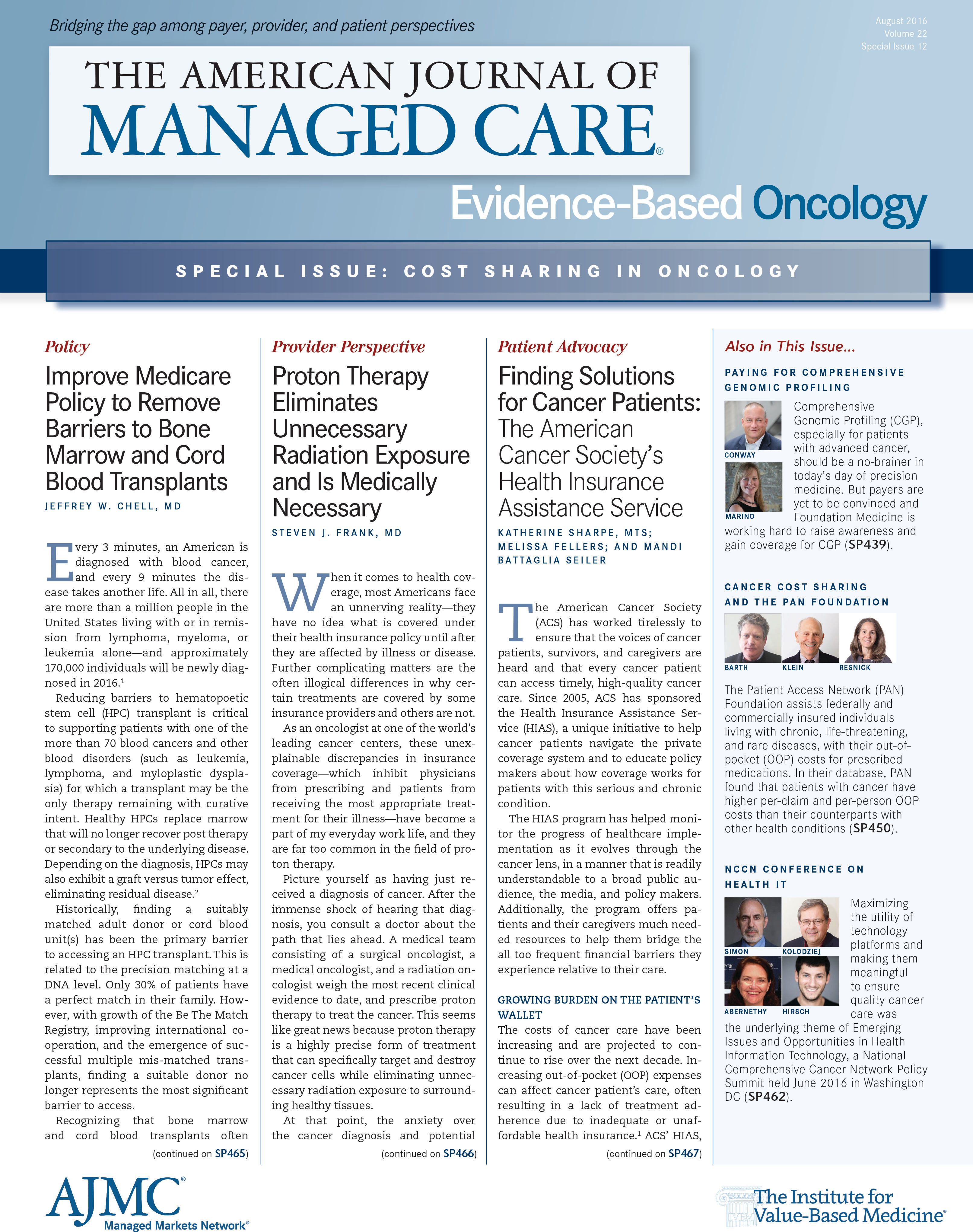- Center on Health Equity & Access
- Clinical
- Health Care Cost
- Health Care Delivery
- Insurance
- Policy
- Technology
- Value-Based Care
Paying to Make Health IT Meaningful: A Discussion at the NCCN Policy Summit
Maximizing the utility of technology platforms and making them meaningful to ensure quality cancer care was the underlying theme of Emerging Issues and Opportunities in Health Information Technology, a National Comprehensive Cancer Network Policy Summit, held June 27, 2016, in Washington, DC.
Maximizing the utility of technology platforms and making them meaningful to ensure quality cancer care was the underlying theme of Emerging Issues and Opportunities in Health Information Technology, a National Comprehensive Cancer Network Policy Summit, held June 27, 2016, in Washington, DC.
The first panel discussion, Readiness to Support Alternative Payment Models and Reporting for Precision Medicine and Quality Care, saw participation by a payer, providers, and developers of technology platforms. Participants included Amy Abernethy, MD, PhD, Flatiron Health; Jonathan Hirsch, Syapse; Michael Kolodziej, MD, Aetna (who has since joined FlatIron Health); Mia Levy, MD, PhD, Vanderbilt Ingram Cancer Center; Alexandra Mugge, MPH, CMS; Marcus Neubauer, MD, McKesson Specialty Health; Allen Roeseler, NantHealth; and Bret Shillingstad, MD; Epic Systems Corporation.
Data silos that emerge because systems do not speak with each other is a significant problem. How does this absence of information affect patient care? Neubauer said that interoperability is a problem for healthcare systems. “Within our system, we are internally networked well enough to not have any such issues. Otherwise, clinics have to significantly depend on patient reporting,” he said, which can sometimes be a challenge.
With respect to measuring the quality of care delivered, the more information the better. “Clinical pathways involve a design component, and then there’s compliance,” explained Neubauer. They are both distinct. We have [developed] capabilities to generate and share reports on compliance with payers.”
Mugge said that at CMS, “We try to listen to clinicians to make measures more meaningful. They could be targeted. Like just for [electronic health records (EHRs)].”
What is the most significant barrier for data mining across systems? According to Levy, it’s how the data is extracted. “Quality metrics have been around for a long time, but they have not been grounded in the feasibility of measuring something—while measures may be process-oriented, they are not easy to extract,” Levy said. “The feasibility of being able to extract data in a more automated fashion is important,” she said. Roeseler agreed. “We have these vast data sets…the question is, how do you access this information?” According to Shillingstad, specialty organizations and registries play a very important role in the process, and a registry of standards for data extraction can be established for oncology.
“The interesting thing with oncology is that some of the new data sources lend the opportunity to monitor and implement workflow changes and process changes. We have been able to work with one of these to institute such workflow changes,” added Hirsch.
But the necessary changes have to be implemented now, at the point where physicians and clinics are preparing to submit their reports for the Merit-Based Incentive Payment System (MIPS), a measurement tool of the Medicare Access & CHIP Reauthorization Act of 2015, and its other option, alternative payment models (APMs). “So, Flatiron is working to get data organized to introduce it into registries and data sources,” Abernethy said. “It’s also important to record those quality measures that matter, and I foresee 2 challenges with that: the need for quality measures that are aligned with the current data systems and developing measures that are flexible enough to alter, based on outcomes.”
Neubauer complimented the way in which CMS’ Oncology Care Model (OCM)1 has been developed. “Initially, there were 20 quality measures within the OCM, and now they have been reduced to 12, 4 of which are requirements of the [Physician Quality Reporting System]. So, quality metrics change as the program evolves. They were smart to do that with [the] OCM,” he said. “While decision support tools are a good idea, they should contribute to making the physician workflow smoother, and not add to their burden,” Neubauer added.
Abernethy pointed out that physicians should remember to only add information that they need to enter. “If it’s not necessary information, the physician’s quality report drops off.”
How can health IT platforms support APMs? Kolodziej said, “Oncologists are responsible for understanding the clinical profile before they treat the patient. MIPS and OCM are transitional models, not the end game. To understand the clinical information and then come up with alternatives for care…we need health IT.”
Shillingstad believes that although EHRs can support models, such as bundled payment and episodes-of-care, the complexity rises several notches with oncology. According to Abernethy, software solutions that guide physicians and buyers to the right solutions is the basic requirement. Additionally, predicting risks by using algorithms that can forecast which patient is at risk for specific problems. “EHRs create a community practice. They create a mechanism for community oncologists to relate to each other and help each other,” Abernethy said, which was the objective behind FlatIron’s cloud-based EHRs.
“Cloud-based technologies and machine learning can provide increased data access. Cloud-based technologies and aggregated data can provide the solution,” said Roeseler. Hirsch agreed. “Cloud-based systems, as Amy said, can help physicians share and learn from each other. We are currently collaborating with health systems on this.”
EBO
“Most of what is coming back is that customers are driving development,” Shillingstad added. REFERENCE
1. Dangi-Garimella S. CMS announces practices and payers participating in the OCM. The American Journal of Managed Care website. http://www.ajmc.com/newsroom/cms-announces-practices-and-payers-participating-in-the-ocm. Published June 29, 2016. Accessed July 25, 2016.

Trends in Hospital Pricing for Vulnerable Emergency Department Users, 2021-2023
December 4th 2025Self-pay emergency department prices rose significantly from 2021 to 2023, especially at for-profit and system-affiliated hospitals, highlighting growing affordability challenges for uninsured and underinsured patients.
Read More

